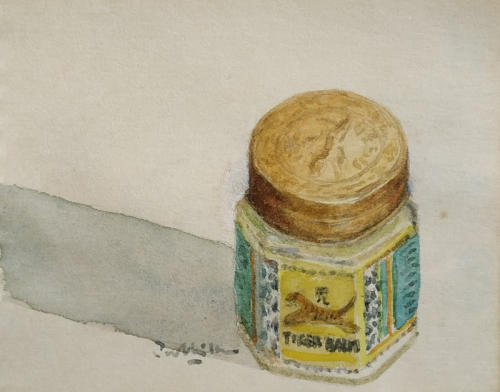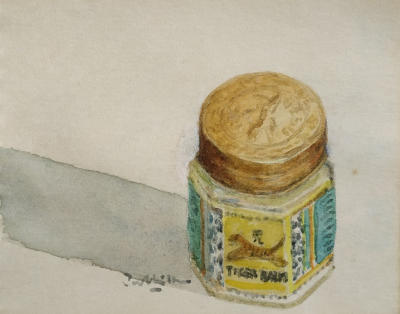Tiger Balm: Healing, Nostalgia, and Beyond
Within the vibrant colours and rich textures of this painting lies not just
an ointment but a repository of memories, a symbol of hope and
healing, and a reflection on the multifaceted role of products in our
lives.
Tiger Balm, a familiar and cherished topical ointment, has been a part
of countless childhood memories, providing comfort in times of minor
aches, pains, and discomfort. In this canvas, the artist sought to capture
not just the visual representation of the ointment but the emotions it
evokes—the warmth of nostalgia, the promise of relief, and the sense
of wellness it imparts.
This ointment, with its soothing properties, carries with it a sense of
hope and healing. It is a balm for both physical and emotional ailments,
a source of solace during moments of discomfort.
Tiger Balm became a famous household item in Singapore soon after
its introduction in 1924. The Aw brothers, who developed the product,
were aggressive marketers. They used a variety of methods to promote
Tiger Balm, including newspaper and magazine advertising, billboards,
and even a theme park called Haw Par Villa. It was a fixture in every
household, embodying a Chinese traditional remedy and a holistic
approach to health and well-being. It is a testament to the wisdom
passed down through generations, a reminder that nature's remedies
can offer profound comfort and relief.
Beyond its healing qualities, this painting also seeks to convey a sense
of empowerment and energy. Just as Tiger Balm is known for its
versatility and multiple uses, from relieving muscle aches to providing a
refreshing sensation, the painting itself symbolizes adaptability and the
ability to serve different purposes. It reminds us of the resilience
inherent in all aspects of life, the capacity to transform and provide
comfort in various forms.
However, this painting also serves as a commentary on consumerism,
advertising, and the impact of commercial products on society. In a
world where products often define our choices and shape our
experiences, it calls us to reflect on the role of consumer culture and
the messages that surround us. It prompts us to consider how products
become woven into the fabric of our lives, shaping our memories and
perceptions.
As viewers contemplate this artwork, may it stir their own memories
and associations with familiar products. Let it be a reminder of the
power of healing, the warmth of nostalgia, and the adaptability that
resides within us all. In Tiger Balm, there is found not just a topical
ointment but a multifaceted symbol of comfort, resilience, and the
ever-evolving relationship between products and society.



Tiger Balm: Healing, Nostalgia, and Beyond
Within the vibrant colours and rich textures of
this painting lies not just an ointment but a
repository of memories, a symbol of hope and
healing, and a reflection on the multifaceted
role of products in our lives.
Tiger Balm, a familiar and cherished topical
ointment, has been a part of countless
childhood memories, providing comfort in
times of minor aches, pains, and discomfort. In
this canvas, the artist sought to capture not just
the visual representation of the ointment but
the emotions it evokes—the warmth of
nostalgia, the promise of relief, and the sense
of wellness it imparts.
This ointment, with its soothing properties,
carries with it a sense of hope and healing. It is
a balm for both physical and emotional
ailments, a source of solace during moments of
discomfort.
Tiger Balm became a famous household item in
Singapore soon after its introduction in 1924.
The Aw brothers, who developed the product,
were aggressive marketers. They used a variety
of methods to promote Tiger Balm, including
newspaper and magazine advertising,
billboards, and even a theme park called Haw
Par Villa. It was a fixture in every household,
embodying a Chinese traditional remedy and a
holistic approach to health and well-being. It is
a testament to the wisdom passed down
through generations, a reminder that nature's
remedies can offer profound comfort and
relief.
Beyond its healing qualities, this painting also
seeks to convey a sense of empowerment and
energy. Just as Tiger Balm is known for its
versatility and multiple uses, from relieving
muscle aches to providing a refreshing
sensation, the painting itself symbolizes
adaptability and the ability to serve different
purposes. It reminds us of the resilience
inherent in all aspects of life, the capacity to
transform and provide comfort in various
forms.
However, this painting also serves as a
commentary on consumerism, advertising, and
the impact of commercial products on society.
In a world where products often define our
choices and shape our experiences, it calls us
to reflect on the role of consumer culture and
the messages that surround us. It prompts us
to consider how products become woven into
the fabric of our lives, shaping our memories
and perceptions.
As viewers contemplate this artwork, may it stir
their own memories and associations with
familiar products. Let it be a reminder of the
power of healing, the warmth of nostalgia, and
the adaptability that resides within us all. In
Tiger Balm, there is found not just a topical
ointment but a multifaceted symbol of comfort,
resilience, and the ever-evolving relationship
between products and society.






















